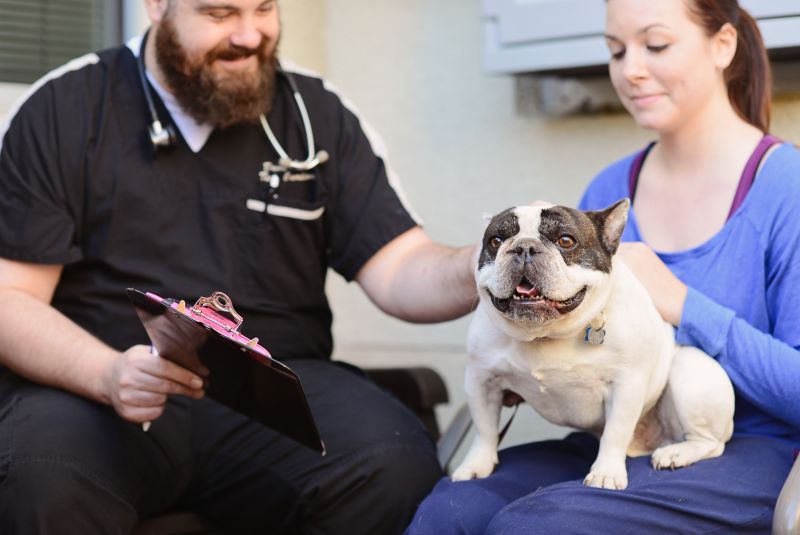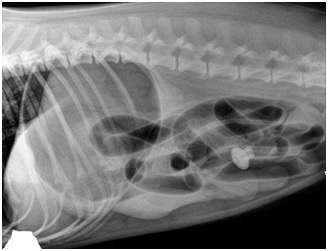
Does your pet eat things that they shouldn’t? If your pet loves to explore the world by putting it in their mouth, then this article is for you. If your pet has ingested something, such as a sock, we call it a foreign body—something that is sitting in their stomach or intestines that should not be there.
Types of foreign bodies
Here are some of the more common foreign bodies we see:
Socks or underwear
Towels
Toys such as tennis balls
Rocks
The list goes on and on…
It is important to note that if your pet has eaten string or fabric with string-like qualities it becomes a much larger emergency. These are specifically labeled “linear foreign bodies” and can cause much more devastating damage to the intestine. We will go into more detail a little bit later on in the article.
Signs of a foreign body
It depends on if the object swallowed is causing a full or partial obstruction (aka blockage). A full obstruction means nothing can get past the object. Here’s what happens: picture yourself watering your lawn with your garden hose. Now, halfway down the hose, you twist it to cut off water flow – the section of hose before you made the twist will start to build up pressure as water backs up within it. It will stretch and distend and eventually, it may burst open. This is what can happen with a full obstruction. Fluid continues to build up in the intestine, stretching it and causing it to hold more volume than it was ever supposed to – this causes pain, lethargy, unwillingness to eat (or severely decreased appetite) and vomiting – lots of it.
If we are instead dealing with a partial obstruction, we may see intermittent vomiting and diarrhea, with partially decreased appetite and decreased energy level.

How do you diagnose it?
Foreign bodies are diagnosed primarily by taking x-rays. Certain objects like rocks, metal and some types of balls will show up easily on the x-ray. Most of the time though, we have to look at the intestines themselves to give us the answer. If you go back to my garden hose analogy, we are looking for very dilated gas-filled intestines, as we can see to the right. You can also see the foreign body in this picture (metal handle from a drawer).
A note on linear foreign bodies
Cats are most famous for these, as they often have a strong affinity for playing with string or yarn. However, we do also find them in dogs if they have eaten certain types of fabric.
Linear foreign bodies are unique in that they often will get anchored in the stomach and as the intestines try to move the remaining stretch of string along, it will create a drawstring effect. The intestines bunch up and the string will actually start to saw through the intestines. The damage is frequently along multiple sections of intestines and is much more severe than what we see with a simple foreign body. Due to this, if we have suspicion for a linear foreign body, we will recommend surgery immediately.
How do you treat them?
When we see evidence of a foreign body, we will often try to let it pass on its own (an exception to this is the linear foreign body). Hospitalization on IV fluids allows it the best chance (with the additional benefit of replacing hydration the pet has lost). Typically we will recommend they be hospitalized for the day or overnight (depending on what time of day you’re seen) with recheck x-rays to see if the object is moving along or not.
If the object is not moving, surgery is then deemed necessary. It’s important to intervene before the intestines have stretched too much because we want to avoid causing too much damage to them. If the intestines stretch too dramatically they will start to tear or open up, which we call perforation. If this happens, the bacteria within the intestines can enter into the abdomen causing infection (peritonitis or septic abdomen) and a very sick pet. This can be life-threatening and fatal.
Usually the foreign body can be removed by making a small incision in the intestine and pulling it out. If there is widespread damage to the section of intestine where we think it will not be able to recover, we may need to take that damaged section out (called a resection and anastomosis).
As we always say, prevention is the best medicine. If at all possible, try to keep socks and underwear off the floor and out of reach from your pet. If they love to chew on certain items, make sure they have no opportunity to get to them. And if they love to explore the world by putting it in their mouths, walk them on leash so you can pull them away before they ingest anything they shouldn’t. But if they do happen to eat something they shouldn’t and you see it – bring them in to us – more often than not, we can make them vomit it up in the hospital to prevent it from becoming a surgical problem.
Tags: foreign body obstruction, ask the vet, stefanie wong dvm







